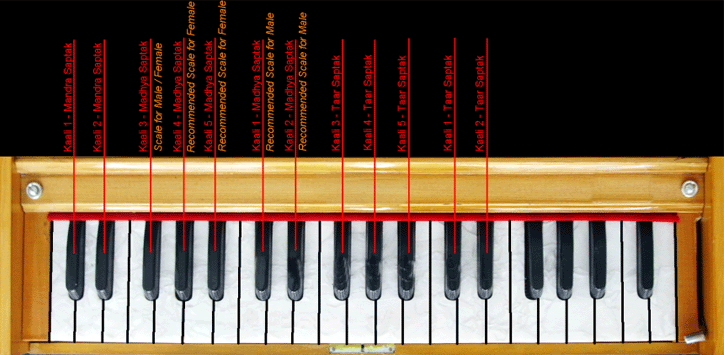|
How to Read Notation All notations on this site have been prepared in Hindustani Classical Music Notation system using english fonts. Some of these notations have also been recorded in Midi format. Please click here for a sample Notation and sample Midi. Here are some guidelines to sign conventions for reading these notations : Seven Shuddha Swar (Pure Notes indicated without any bars): Sa, Re, Ga, Ma, Pa, Dha, Ni
Saptak (Octave) is a complete set of notes from one base note (Sa) to the next. Madhya Saptak (Middle Octave): The octave achieved by normal frequency of voice. These notes are indicated without any dots above or below. Sa, Re, Ga, Ma, Pa, Dha, Ni Mandra Saptak (Lower Octave): The octave before Madhya Saptak. This has lower notes. These Notes are indicated by placing a dot beneath the corresponding note.
Taar Saptak (Higher Octave): The octave after Madhya Saptak. This has higher notes. These Notes are indicated by placing a dot above the corresponding note.
Matra (Beat): Equally spaced strokes (pulsations), which are units of measuring a Taal (Cyclic Rhythm). ” – ” (A Dash) : Employed for lengthening a Note by one beat. Sa – Pa - ” S ” Avagrah: It is used for lengthening the in words of lyrics. ra S S S dha Chandra (Half Moon): All Notes inside the half moon are rendered in one Matra (Beat).
” ( ) ” Note within Brackets: The Note within brackets is sung very fast to include notes after and before it, so that the notes blend and sound as one Note. The order for these Notes is – one Note after the Note in brackets, the Note in brackets, the Note before and finally the Note in brackets. ( Pa ) – Dha Pa Ma Pa Kan Swar (Grace Note): A note is written in small font on top left corner of another note. This means the Note in small font needs to be touched enroute to the next note. In the following example, Ma is the Kan swar.
Meend: Indicated by a reverse moon on top of the corresponding notes. This means the next note should be gradually reached rather than jumping on to it. In the following example, the route from Sa to Pa will comprise all the intermediate notes.
Taal (Cyclic Rhythm): Taal can be defined as a cycle of beats (Matra). Taal typically has Khands (Columns) divided by bars. The start of a Khand may be either Taali (accentuated) or Khaali (non accentuated). Khand (Columns): As explained above, a Taal is divided by using bars. Each interval between the bars is called a Khand. Sum (First Beat): First beat of Taal is called Sum and is indicated by a cross below the corresponding beat. X Taali: Starting of an accentuated Khand is called a Taali. Typically, both Left and Right drums of Tabla are played to accentuate the Taali. Taali of Sum is taken as the first Taali and the following Taalis are numbered and indicated with numbers 2 onwards. 2, 3, 4 . . . . Khaali: The non accentuated start of a Khand is called a Khaali. Typically, only treble or Right tabla is played on Taali. It is indicated by placing a 0 below the corresponding beat. 0 Notation: Please see below an example of Notation composed in Teentaal (16 beats). Scale : It is also known as the Mool Swar (Base Note, which is Sa). See Illustrations below to get an idea of scale :
This Illustration lists the commonly used scales in Indian Classical Music and their respective relevance to Male or Female voices Illustrated below, are two of the most commonly used scales in Indian Classical Vocal Music, namely Kaali-1for male voices and Kaali-4 for female voices. The notes should be adjusted accordingly for other scales such as Kaali-2, Kaali-3 & Kaali-5.
This Illustration provides the scale of Kaali-1 (1st Black Key is considered to be the Sa). This scale is mostly suitable for male voices. This Illustration provides the scale of Kaali-4 (4th Black Key is considered to be the Sa). This scale is mostly suitable for female voices. Similarly, the scales of Kaali-2, Kaali-3 & Kaali-5 can also be generated. Each one of us has his or her own scale and should identify it before starting to sing. Equivalency of Indian and Western scales : This illustration demonstrates the equivalency of Indian and Western scales when White-1 (Safed-1) key of Harmonium is taken as Sa of Indian scale. It is also very obvious from the illustration above, that : Indian scale of Kaali-1 is equivalent to scale of Db of Western scale Indian scale of Kaali-2 is equivalent to scale of Eb of Western scale Indian scale of Kaali-3 is equivalent to scale of F#/Gb of Western scale Indian scale of Kaali-4 is equivalent to scale of Ab of Western scale Indian scale of Kaali-5 is equivalent to scale of Bb of Western scale
|
Warning: Illegal string offset 'output_key' in /home/school60/public_html/wp-includes/nav-menu.php on line 601
Warning: Illegal string offset 'output_key' in /home/school60/public_html/wp-includes/nav-menu.php on line 601
Warning: Illegal string offset 'output_key' in /home/school60/public_html/wp-includes/nav-menu.php on line 601
Warning: Illegal string offset 'output_key' in /home/school60/public_html/wp-includes/nav-menu.php on line 601
Warning: Illegal string offset 'output_key' in /home/school60/public_html/wp-includes/nav-menu.php on line 601
Warning: Illegal string offset 'output_key' in /home/school60/public_html/wp-includes/nav-menu.php on line 601
Warning: Illegal string offset 'output_key' in /home/school60/public_html/wp-includes/nav-menu.php on line 601
Warning: Illegal string offset 'output_key' in /home/school60/public_html/wp-includes/nav-menu.php on line 601
Warning: Illegal string offset 'output_key' in /home/school60/public_html/wp-includes/nav-menu.php on line 601







